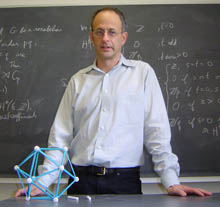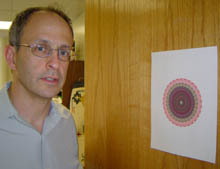| University of Maryland Professor Helps Unravel Mathematical Conundrum
|
| Professor Jeffrey
Adams (Newsline photo by Diego Mantilla) |
By Diego Mantilla
Maryland
Newsline
Thursday, May 3, 2007
COLLEGE PARK, Md. – Imagine
a set of formulas -- 200 billion of them -- that describes the possible
symmetries of a 248-dimensional object.
Now imagine getting a computer
to write those formulas.
Professor Jeffrey Adams of the Mathematics
Department at the University of Maryland and an international team of a
dozen and a half colleagues
did just
that.
They unraveled the inner workings of E8, a mathematical entity first
conceived of more than a century ago, but whose structure had never been
understood in detail until the team's breakthrough in January.
E8 is “quite important in understanding the symmetries of the natural
world," said Professor Jonathan Rosenberg, Adams’ colleague at the
University of Maryland.
E8 is part of a set known as
“exceptional Lie groups” that represent infinite symmetries. For example, a
sphere floating in space has an infinite number of symmetries. It can be
turned, flipped or spun any number of ways, and it would look the same.
Insights gathered by mapping
E8, the most complex of Lie groups, could further the understanding of the
structure of the universe, according to mathematicians familiar with the
project.
"The laws of physics have to be independent of what direction you are
looking at," Rosenberg said.
Although very speculative, there is even the possibility that the mapping of
E8 might reap benefits in theoretical physics, said Professor David Vogan of
the Department of Mathematics at MIT. Vogan worked with Adams on the
project.
The speculation is that the information Adams and his colleagues gathered
while studying E8 could be used in the development of string theory, a
theory of the form of the universe at a sub-atomic level, and, perhaps, the
basis for a theory that would unify all of known physics.
Adams, 50, of Baltimore, began teaching at the University of Maryland in
1986. Lie groups have been the sole focus of his academic career, which
stretches back more than two and a half decades. He received his Ph.D. at
Yale in 1981.
"We are pencil and paper kind
of people," Adams said. But to reveal the structure of E8, Adams and his team
had to resort to heavy computing power.
Several factors made it possible. According to Adams, the technology and the
math had improved since the idea of E8 was introduced more than a century
ago. But, he said, "Part of what it took was just the will."
The mathematical basis for the work was in place for a long time, largely
completed by the 1980s, Vogan said. He was one of the authors of a series of
papers that laid the theoretical groundwork for the project decades ago.
"What was missing was somebody to go to the enormous effort of putting this
in computer software," he said.
Someone had to come up with an algorithm, a step-by-step way of telling a
machine what to do.
That was the part that Adams was most involved in.
Adams, Vogan and Professor Fokko du Cloux, of Université Claude Bernard Lyon
1 in France, took highly complicated, abstract mathematics and filtered or
boiled it down to steps that could be implemented by a machine.
"To actually do that is incredibly hard," Adams said.
After more than two years of work, he and the team produced what is known as a "character table," a matrix that holds
all the symmetries of a certain geometric body.
Adams pulls a huge folio out of his bookcase. It is titled "Atlas of Finite
Groups." It was published by Oxford University Press more than two decades
ago. He flips the pages to one that describes the icosahedron, an object
with 20 triangular faces.
Adams holds a 1-foot-tall model of an icosahedron. He flips it 180 degrees
and explains that if one turns the icosahedron on its axis, one gets the
same figure. That is one symmetry.
Now he rotates the icosahedron so that the five joined triangles of its top
apex face the viewer one at the time. Each time the figure looks the same.
That is another symmetry.
Each one of these symmetries is neatly noted in the Atlas -- each one on a
spreadsheet of numbers. The one for the icosahedron spans no more than a
dozen rows and columns.
|
| Professor Jeffrey Adams
with a representation of E8 posted on his office door. (Newsline photo by Diego Mantilla) |
Then Adams flips the pages
and the spreadsheets get bigger and bigger. The one for the "Monster" group
spreads over several pages, each with a huge table in tiny print.
That, in essence, was Adams' job: to create a huge spreadsheet that would
contain all the symmetries represented by E8.
The character table itself
has 453,060 rows and 453,060 columns. If printed, it would cover an area the
size of Manhattan. In computer storage, it occupies 60 gigabytes in a highly
compressed format.
Since E8 is the representation of infinite symmetries, each cell in the
spreadsheet holds a formula in which a variable can be plugged.
Adams and his colleagues produced 200 billion different formulas, each of
which can appear in infinitely many ways.
The calculation required a custom-made computer at the University of
Washington, called SAGE, which had 64 gigabytes of memory.
The person who
coded the E8 algorithm into C++, a computer programming language,
was Du Cloux. He did not
live to see the work finished. He died late last year of the
neurological
disease ALS, also known as Lou Gehrig's disease.
The final push, wrote Adams
in an e-mail, was done by Vogan and Professor Marc Van Leeuwen, of
Université de Poitiers in France, who took Du Cloux’s code and implemented
it so it would use less memory.
SAGE crunched the numbers for
77 hours, before completing the final calculation on the morning of Jan. 8.
But before that, Adams, Vogan
and Du Cloux worked for more than a year, doing hundreds of experiments,
trying to find out how big a computer was needed for the final calculation.
To work on E8, Adams, Vogan and Du Cloux met yearly at mathematics
workshops. They also communicated by e-mail.
“Certainly this project has
been a lot of work, but it has mostly been of the fun and pleasant kind,”
Adams wrote in an e-mail. “I work a lot at home, in off hours, after the
kids go to bed and such. This is my usual mode of operation, only this
project has been a bit more intense, and collaborative.”
For the last few months,
Adams wrote in an e-mail, Du Cloux was confined to his bed in France. They
communicated by projecting the image of a computer screen on his ceiling.
That way he could see what Adams or Vogan were typing.
Adams said he has more work
ahead of him. He and his colleagues hope to put together an atlas of Lie
groups.
Looking back on what they’ve
already accomplished, taking something monstrously complex and distilling it
down to something simple enough for a machine to process, Adams said, "You know
that you really understand something really well when you can implement it
on a computer."
Copyright ©
2007 University of Maryland Philip Merrill College of
Journalism
Top of Page | Home Page
|


